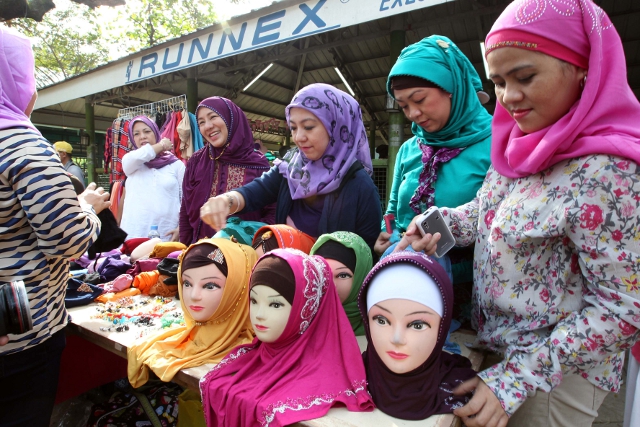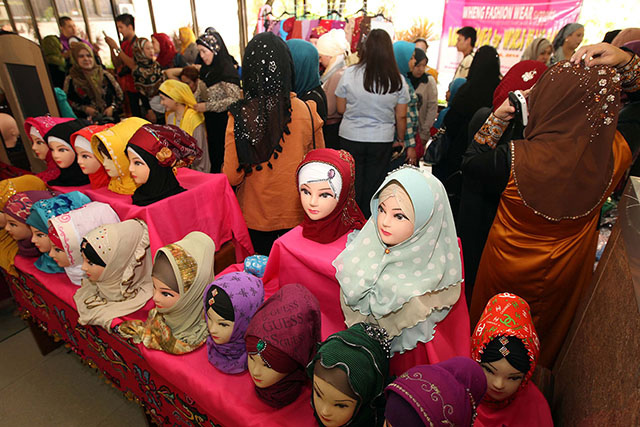Filtered By: Lifestyle
Lifestyle
World Hijab Day celebrates empowerment, freedom, and dignity for all women
By RIE TAKUMI, GMA News

Hundreds of Muslim women gather at the Gazebo Hall of the Quezon City Memorial Circle in observance of World Hijab Day and sign a pledge for unity on Feb. 1, 2014. Analy Labor
For some, the hijab is a sign of oppression. Many think that hijab-wearing women are forced to conceal their hair and bodies, or worse, brainwashed into thinking it is the proper way to dress.
But what do these women really think of their way of dress?
Empowerment, freedom, and expression of religious love is the message the World Hijab Day wishes to impart as it invites women from all walks of life to wear a veil and liberate themselves.
The event was created by Nazma Khan, a New York resident, who wanted to foster religious tolerance and understanding by inviting both non-Muslim and non-Hijabi Muslims to join the event on February 1.
In a statement, WHD Philippine Ambassador Ammarah Sahara Biruar-Dumama said that a failed understanding of Islamic teaching is behind the common misconception of the the hijab oppresses Muslim women.
"Liberation means freedom, but not to do as one pleases... Islam has no fixed standard as to the style of dress or type of clothing that one must wear," said Dumama.
Women interviewed by the WHD explained that stereotypes, not the practice, hold them back. An example is men forcing women to conceal themselves, to which one woman responded with, "I don't have to do anything if I don't want to."
"I want people to judge me for who I am rather than what I look like. I don't think any person likes it when somebody just likes them for what they look like. They should like them for our personalities—and that's what we strive for as human beings," said an interviewee.
Another explained that both women and men are asked to dress modestly in the Qur'an. A third said it was a free choice to wear the veils, as a show of respect to their religion.
In another video, the WHD explained that hijabs are worn to "shift the focus away from a woman's physical appearance in order towards her character and merit to her personality."
"A woman who covers herself is concealing her sexuality and is allowing her femininity to be brought out. The idea is to obey her Creator over the creation," said Dumama in the statement.
In terms of social mobility, the women said they actually found life under the veil liberating. A GMA News Online reporter, in a special report that also details the different names of the hijab, found out that wearing a hijab does open doors—sometimes literally—that would not be opened so readily otherwise.
No reactions from DepEd, CBCP
GMA News Online tried contacting all-female schools in Metro Manila on Saturday to ask if they are observing the event, but only Miriam College managed to respond. Despite this, Miriam's College of International, Humanitarian and Development Studies revealed they had not received any memos alerting them to the event.
Both the Department of Education (DepEd) and the Catholic Bishops' Conference of the Philippines have yet to give reactions.
International praise and criticisms
Hijabi women from Mindadano observed the event by showing various hijab styles at the Dare to Cover event, held at the House of Representatives last Wednesday.

Women from Mindanao showcase their different hijab styles at the Dare to Cover event for World Hijab Day held at the House of Representatives in Quezon City on Wednesday, January 29. GMA News
Other countries are also celebrating the event, with the Canadian Council of Muslim Women telling radio station CJAD it was a timely event for their country, while All Africa reported that veiled women need to be protected from discriminatory acts.
On their official Facebook page, women from all backgrounds around the world expressed their support, and the hashtag #WorldHijabDay is used on Twitter to commemorate the event.
While support for WHD is overwhelming, some organizations have expressed concerns that the event is merely a yearly fashion fad that fails to raise real awareness.
A writer for Muslim webzine Taqwa Magazine expressed that those who only wear it for a day cannot truly understand the religion behind the veil. Interfaith website Patheos expressed the same concern, saying non-Muslim and non-Hijabi Muslims focused on how they felt about wearing the veil, instead of thinking about the challenges hijab-wearing women face.
No discrimination in work, school, public
A bill prohibiting racial profiling and discrimination was passed in the senate in 2011 named Senate Bill 2814 or the "Anti-Ethnic or Racial Profiling and Discrimination Act of 2011."
The bill brands discriminatory practices against employees, students, and tenants as illegal. Violation of the bill is punishable by imprisonment imprisonment and fines reaching P100,000.
This bill works in conjunction with the Section 28 of the Magna Carta of Women, which allows teachers and students to wear the hijab and other religious articles of clothing in learning institutions.
Under Section 28, the Commission of Human Rights (CHR) said Moro and indigenous women are allowed to "practice, promote, protect, and preserve their own culture, traditions, and institutions and to consider these rights in the formulation and implementation of national policies and programs.”
Despite this, DepEd "strongly suggested" that Muslim teachers have to remove their veils while teaching the Arabic language in order to teach effectively. — VC, GMA News
Tags: worldhijabday
More Videos
Most Popular



